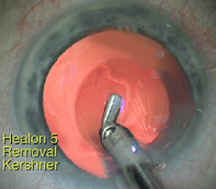Healon
5-Seven Tips for Clear Corneal Cataract Surgery
Robert M. Kershner, MD, MS, FACS*
Director Emeritus of Cataract and Refractive Surgery, Eye Laser Center, Tucson, Arizona USA
Clinical Professor of Ophthalmology, John A. Moran Eye Center, University of Utah School of Medicine, Salt Lake City, Utah
Ik Ho Visiting Professor of Ophthalmology, Chinese University of Hong Kong
President and CEO, Eye Laser Consulting, Boston, Massachusetts USA
web site: http://www.EyeLaserConsulting.com/PhysicianResource.htm
Today's cataract surgery depends upon the latest techniques, state-of-the art instrumentation and the latest advances in ophthalmic viscosurgical devices technology. To maximize the benefits of the various ophthalmic viscosurgical devices (OVDs) offered, such as Healon, Healon-GV and Healon-5, surgeons need to know the differences in their behavior and their unique handling characteristics. When performing the demanding techniques of advanced microincision cataract surgery, which OVD should the surgeon select? Is one really better than the other, and do I need more than one?
What is Hyaluronate? Sodium hyaluronate , or Hyaluronic acid (HA) is a polysaccharide composed of repeat disaccharide units of N-acetylglucosamine and glucuronic acid. Commercial HA is commonly provided in its sodium salt form. Sodium hyaluronate is the key water maintaining substance in human skin. The special structural characteristics of HA makes it a highly moisturizing and water-regulating function. Its solution has high viscoelasticity and lubricity.
The plethora of offerings from manufacturers of present day OVDs looks like a smorgasbord at an all-you-can-eat restaurant. How can a surgeon sort out the fact from hype and effectively apply the appropriate device to the proper procedure? If we understand the differences in the various products, we will be more effective in choosing the right one for the right job. In order to better understand the products, I categorize them by their performance characteristics and divide them into three different groups: dispersive, cohesive and adaptive . Dispersive OVDs refer to that family of OVDs which includes: 2% hydroxypropylmethylcellulose (Occucoat-Bausch and Lomb), 1.3% hyaluronate (Vitrax-AMO, Inc.) and Hyaluronate-Chondroitin (Viscoat-Alcon). They tend to be looser and as the name describes, disperse easily inside the eye. Cohesive OVDs refer to that family which includes: Hyaluronate 1% (Healon, AMO-Inc.), and Hyaluronate 1.4% (Healon GV, AMO-Inc). These products are of greater molecular weight, uniformity and complexity and therefore are more dense and tend to stick together inside the eye. Adaptive OVDs refer to that family which includes Hyaluronate 2.3% (Healon 5, AMO-Inc). As a very large molecule with a complex structure, this latest addition to our armamentarium of viscosurgical devices, the viscoadaptive Healon-5, has unique handling and intraocular properties. The large molecular chain allows the viscoadaptive to actually change it's characteristics depending upon the way it is used.
Why have surgeons waited for a viscoadaptive? The viscosity of a substance such as Healon-5 allows it to change its characteristics when injected. It can behave like a viscodispersive in circumstances such as filling the capsular bag for IOL injection or it can act like a viscocohesive to separate tissue, such as for phaco tip insertion. In this fashion it is adaptive, creating better control of tissues during surgery depending upon the circumstances in which it is used. Healon 5 can control tissue positioning, is optically clear, and creates and maintains space within the eye, without breaking apart or washing out. As surgeons have recognized with other OVD products, these substances must be completely removed at the conclusion of the surgery to avoid lingering effects on postoperative intraocular pressure .
The cataract surgeon can apply Healon 5 from the start of the surgery. First, make your usual incision. I prefer a 2.8mm clear corneal incision placed on the steep meridian, which can neutralize preexisting astigmatism. If the cornea is astigmatically neutral, a plane parallel cataract incision can be made on clear cornea. The ideal self-sealing incision architecture is an external arcuate incision, which approximates an internal rectangular configuration. The ratio of incision width to length should be 3:2. Always create an incision that accommodates the techniques and instruments you will use.
Clinical experience with many OVDs has allowed me to chose Healon 5 for general use in cataract surgery. I do not reserve it just for difficult cases, such as narrow chambers or dense cataracts. Properly applied, Healon 5 performs superbly under the most common circumstances as well as the most challenging cases encountered. Because Healon-5 remains in the anterior chamber to protect the endothelium during phaco, it provides excellent control for difficult cases.
To be better able to maximize the benefits of Healon 5, I list seven tips for it's use in today's high tech cataract procedure.
Tip #1 : Facillitate Capsulorrhexis . Healon-5 deepens the anterior chamber for capsulorhexis and reduces stress on the capsule and zonules ( Figure 1 ) . By inserting Healon-5 onto the center of the lens capsule prior to making the capsulorrhexis, the anterior lens capsule can be pushed posteriorly reducing stretch on the zonules. Because it occupies space so efficiently, it is important caveat not to overfill the anterior chamber with Healon-5. Overfilling the eye, makes instrument introduction, capsulorrhexis, hydrodissection and IOL insertion more difficult. With Healon-5 in place, the one-step capsulorrhexis forceps (Rhein Medical, Tampa, Florida USA) can be used to open the capsule and conduct the tear with a single instrument ( Figure 2 ) .
Next, hydrodissection can be performed with a Binkhorst cannula and balanced-salt solution irrigation just under the incision to prematurely loosen the cortical attachments from the lens capsule.
Tip #2: Aid Phaco Tip Insertion. Insert Healon-5 under the incisional lip to aid in insertion of the phaco tip at the start of the phaco procedure ( Figure 3 ) . Healon-5 occupies space, allowing tip passage to occur without catching the iris, Descemets membrane or the incisional lip.
Tip #3: Protect during Phaco. Keep the phacoemulsification within the triangle of safety. Insert Healon 5 into the center of the anterior chamber during the phaco procedure to separate pieces and keep the cataractous lens in the iris plane and away from the corneal endothelium.
Tip #4 : Fill the Bag. Enlarge and expand the capsular bag for controlled intraocular lens implantation. There are several ways to accomplish this. First, the surgeon can fill the capsular bag with Healon Classic. Then place a bolus of Healon-5 in the center of the capsulorrhexis to expand the opening and protect the cornea during IOL injection ( Figure 4 ) . I believe that Healon 5 should not be used exclusively to fill the bag. It is important that there is sufficient space remaining to displace the viscoadaptive when the IOL is injected into the lens capsule. I have found Healon 5 to be ideal in protecting intraocular tissues and for positioning the IOL during implantation.
Tip #5 : IOL Insertion. Healon-5 can be used to control the intraocular lens during implantation. Advances in today's lens designs make Healon-5 an excellent addition to clear corneal cataract surgery especially when implanting, single-piece or three-piece silicone or acrylic lenses. Since the invention of the intraocular lens by Harold Ridley in 1949, we have seen numerous advances in intraocular lens design. AMO's Tecnis IOL is a good example of the latest design advances in the three-piece new technology intraocular lens. This IOL can fixate within the capsular bag, and may result in less postoperative capsular fibrosis due to its unique square edge optic design and capsular loop haptics. However, implantation of the Tecnis may be more challenging because of it's design and therefore is ideal for use with Healon 5.
Tip #6 : Inject the IOL. We can use Healon-5 to inject the intraocular lens ( Figure 5) . Because fluids are non-compressible, inserting the IOL into an overfilled capsular bag can be difficult. But using the viscoadaptive properties of Healon 5 can be advantageous in inserting the IOL. The lens can be placed within the injector cartridge with Healon 5 and Healon 5 can atraumatically move the lens down the cartridge barrel without friction or force.
Tip #7 : Remove Healon 5. Completely remove Healon-5 after implantation of the lens ( Figure 6) . Insert the irrigation/aspiration cannula onto the center of the IOL, and visualize removal of the Healon-5. Leaving any OVD in the eye following the conclusion of intraocular surgery can be associated with a postoperative pressure rise. It is important to completely remove the substance at the conclusion of surgery. The adaptive nature of Healon 5 makes removal simple. Because it sticks together, the I&A tip can remove the substance as a single piece. The surgeon need not irrigate under the IOL or move the I&A tip around to retrieve all of the viscoadaptive. It will easily come out with simple irrigation and aspiration.
If surgeons select and apply OVDs wisely, we can improve the outcome and success of microincision cataract surgery. This new generation of viscoadaptives may be just what the doctor ordered.
For more information, visit http://www.eyelasercenter.com/PhysicianResource.htm
©2005. Robert M. Kershner, MD, MS, FACS. All rights reserved. Dr. Kershner has no financial or proprietary interest in any of the devices or techniques described in this article. Healon, Healon GV, and Healon 5 are registered trademarks and products of AMO, Inc., Sana Ana, CA USA.
Figure 1. Inject
Healon 5 onto the center of the lens prior to capsulorrhexis to reduce
stress from the zonules on the lens capsule.
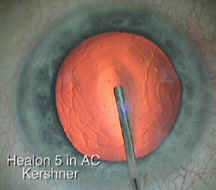
Figure 2. Perform
capsulorrhexis under a bolus of Healon 5 to aid in control of the capsule.
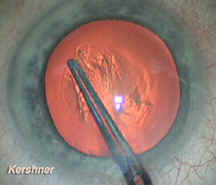
Figure 3. Insert
Healon 5 under the incision and onto the surface of the cataract to aid in
phaco tip passage.
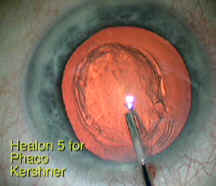
Figure 4. Place
a bolus of Healon 5 into the center of the capsular bag prior to IOL
implantation.

Figure 5. Healon
5 aids in IOL injector insertion and delivery of the IOL.
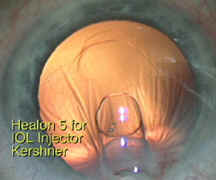
Figure 6. Completely
remove Healon 5 by placing the I&A tip onto the center of the IOL.
